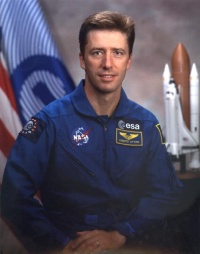Roberto Vittori
From The Space Library
 Roberto Vittori | |
| Birth Name | Roberto Vittori |
|---|---|
| Birth Date | Oct 15 1964 |
| Occupation | Astronaut, European Space Agency |
Contents |
[edit] Personal Data
Born on October 15, 1964, in Viterbo, Italy. Married to the former Valeria Nardi of Citta' di Castello, Italy. They have three children. Enjoys soccer, running, swimming and reading.
[edit] Education
Graduated from the Italian Air Force Academy in 1989. Completed basic training with the U.S. Air Force at Reese Air Force Base in Texas in 1990. Graduated from the U.S. Navy Test Pilot School in 1995. Completed the Italian Air Force's Accident Prevention course (Guidonia A.F.B., Italy) and Accident Investigation course (Kirtland A.F.B., New Mexico) between 1996 and 1997. He holds a master's degree in aeronautical sciences from the University of Naples and a master's degree in physics from the University of Perugia.
[edit] Experience
Following graduation from pilot training in 1990, Vittori flew Tornado GR1 aircraft with the 155th Squadron, 50th Wing, Piacenza, Italy, from 1991 to 1994. During that time, he qualified for day/night air-to-air refueling as well as formation leader.
[edit] Spaceflight Experience
NASA/ESA EXPERIENCE: In 1995, he completed the U.S. Navy Test Pilot School training. He then served at the Italian Test Centre as project pilot for the development of the new European aircraft, the Euro-Fighter EF2000, until 1998. From 1996 to 1998, he was the national representative in the Beyond Visual Range Air-to-Air Missile (BVRAAM) research and development program. In 1997, he attended the U.S. Air Force Flight Safety School and from 1997 to 1998, he was wing Flight Safety Officer at the Italian Test Centre. He was also a teacher of aerodynamics for the Italian Air Force's Accident Investigation Course. Roberto Vittori is a colonel in the Italian Air Force. He has logged nearly 2,500 hours in more than 40 different aircraft types, including F-104, Tornado GR1, F-18, AMX, M-2000, G-222 and P-180. In July 1998, he was selected as an astronaut by the Italian Space Agency (ASI) in cooperation with the European Space Agency (ESA) and, 1 month later, he joined the European Astronaut Corps, whose home base is the European Astronaut Centre in Cologne, Germany. In August 1998, he was relocated to NASA's Johnson Space Center in Houston, Texas, where he entered the 1998 Astronaut class and participated in a training program that qualifies astronauts for future assignment on the space shuttle and International Space Station. Roberto Vittori completed that training in 2000 and subsequently performed technical duties in the Space Shuttle Operations Systems Branch of NASA's Astronaut Office. In August 2001, he took up training as Soyuz board engineer at the Yuri Gagarin Cosmonaut Training Centre (GCTC) in Star City, near Moscow, in preparation for his first spaceflight in spring 2002. In August 2002, Roberto Vittori was relocated to NASA's Johnson Space Center in Houston, where he supported the New Generation Space Vehicles Branch. In October 2004 Roberto Vittori resumed Soyuz training at Star City for his second mission to the International Space Station in 2005. From 2005 onward, while still on the ESA's active astronaut list, Vittori carried out duties for the Italian Air Force and the Italian government. He served as Deputy Head of the International Relations Office of the Air Force, responsible for the feasibility study for launching microsatellites from an airborne platform, as representative of the Defense Department in the Science and Technology Committee of the Italian Space Agency and as a technical coordinator of the joint space initiatives between the Research and Defense Departments. He also taught the semester course "Human Spaceflight" at La Sapienza, University of Rome.In December 2008, Vittori was relocated to the Johnson Space Center to continue his training for future shuttle and International Space Station missions. Vittori was assigned to the crew of STS-134 to the International Space Station. SPACEFLIGHT EXPERIENCE: From April 25 to May 5, 2002, Roberto Vittori flew to the International Space Station as a spaceflight participant, under an agreement between the Russian Space Agency, Roscosmos, the Italian Space Agency and ESA. One of the main goals of this mission, which was named "Marco Polo," was the delivery to the station of a new model of Soyuz spacecraft, the TM-34, to be used by the resident crew in the event of an emergency.From April 14 to April 24, 2005, Vittori flew again to the International Space Station as spaceflight participant. For that mission, called "Eneide," he was the Soyuz flight engineer on both ascent and return, and, as such, he took an active role in piloting and docking the spacecraft. Onboard the ISS, Vittori performed an extensive science experiment program.From May 16 to June 1, 2011, Vittori served as a mission specialist on STS-134 (ISS assembly flight ULF6), the penultimate mission of NASA's Space Shuttle Program. The mission marked the final flight of Space Shuttle Endeavour. During the 14 day mission, Endeavour delivered the Alpha Magnetic Spectrometer (AMS) and spare parts, including two S-band communications antennas, a high-pressure gas tank and additional spare parts for the Dextre robot. This was the 36th shuttle mission to the International Space Station. The STS-134 mission included four spacewalks and was completed in 15 days, 17 hours, 38 minutes and 23 seconds, traveling 6,510,221 miles in 248 Earth orbits.
[edit] Organizations
[edit] Special Honours
Academic award at the Undergraduate Pilot Training, Reese Air Force Base, Texas; honor student at the Test Pilot School, Patuxent River, Maryland; honor student at the United States Flight Safety School, Kirtland Air Force Base, New Mexico; Italian Air Force Top Medals for Special Piloting Skills and for Extended Service (1997).
[edit] Other Information
May-11
